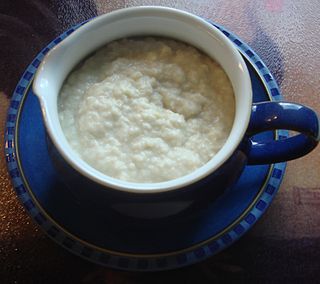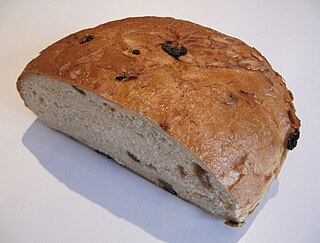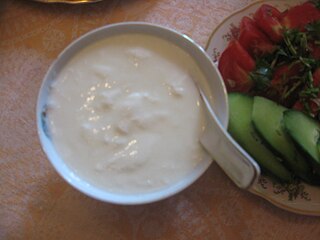Herring soup is a fish soup consisting of a thick mix of water, barley-meal and red herring.

Lasagne are a type of wide, flat pasta, possibly one of the oldest types of pasta. Lasagne, or the singular lasagna, commonly refers to a culinary dish made with stacked layers of pasta alternated with sauces and ingredients such as meats, vegetables and cheese, and sometimes topped with melted grated cheese. Typically, the cooked pasta is assembled with the other ingredients and then baked in an oven. The resulting lasagne casserole is cut into single-serving square portions.

Alan Eaton Davidson CMG was a British diplomat and historian best known for his writing and editing on food and gastronomy. He was the author of the 900-page, encyclopedic The Oxford Companion to Food.

Carbonara is an Italian pasta dish from Rome made with egg, hard cheese, guanciale, and pepper.

A bread sauce is a warm or cold sauce made with milk, which is thickened with bread crumbs, typically eaten with roast chicken or turkey.

Elizabeth "Eliza" Acton was an English food writer and poet, who produced one of Britain's first cookery books aimed at the domestic reader, Modern Cookery for Private Families. The book introduced the now-universal practice of listing ingredients and giving suggested cooking times for each recipe. It included the first recipes in English for Brussels sprouts and for spaghetti, and contains the first printed reference to Christmas pudding.

In many European countries, there are various traditions surrounding the use of bread during the Easter holidays. Traditionally the practice of eating Easter bread or sweetened "communion" bread traces its origin back to Byzantium and the Orthodox Christian church. The recipe for sweetened or "honey-leavened" bread may date back as far as the Homeric Greek period based on anecdotal evidence from classical texts that mention this type of special food. It is also widely known that sweetened bread desserts similar to panettone were a Roman favorite.

Tiropita or tyropita is a Greek layered pastry food in the börek family, made with layers of buttered phyllo and filled with a cheese-egg mixture.

Tsoureki, is a sweet holiday bread made with flour, milk, butter and sugar and commonly seasoned with orange zest, mastic resin or mahlab. One variation commonly called "Easter bread" is made by Greek communities during Easter, not only in Greece, but also in other countries with Greek communities. It is also sometimes called Armenian Easter bread.

Cowboy beans is a bean dish popular in the southwestern United States. The dish consists of pinto beans and ground beef in a sweet and tangy sauce. Other types of meat can be used. The flavor is similar to baked beans but with a southwestern twist. Although cowboy appears in the name, the use of canned beans, ketchup, and barbecue sauce means the dish is unlike anything ranch hands would have eaten in the 19th century. Cowboy beans are served stewed or baked, depending on the recipe.

The Oxford Symposium on Food & Cookery is an annual weekend conference at which academics, food writers, cooks, and others with an interest in food and culture meet to discuss current issues in food studies and food history.
Suaasat is a traditional Greenlandic soup. It is often made from seal, or from whale, reindeer, or sea-birds.

Richard Hosking, a graduate of the University of Cambridge and emeritus professor of Sociology and English at Hiroshima Shudo University, has lived in London since 1998 and is a writer on Japanese food. His best known work is A Dictionary of Japanese Food: ingredients and culture (1996). He is a regular participant at the Oxford Symposium on Food and Cookery and has edited five annual volumes of its proceedings.

Qatiq is a fermented milk product from the Turkic countries. It is considered a more solid form of yogurt than ayran.

Puto cuchinta or kutsinta is a type of steamed rice cake (puto) found throughout the Philippines. It is made from a mixture of rice flour, brown sugar and lye, enhanced with yellow food coloring or annatto extract, and steamed in small ramekins. The cooked cakes are topped with fresh grated meat from mature coconut. It is consumed year-round as a merienda or snack, and is frequently sold along with puto. Unlike its counterpart, which has a doughy texture, kutsina has a jelly-like, chewy consistency. It can be also enhanced by adding latik for a sweeter taste.

Rosquillos are Philippine cookies made from flour, eggs, shortening, sugar, and baking powder. They were originally created by Margarita “Titay” T. Frasco in 1907 in Liloan, Cebu. The name means "ringlet" in Spanish and was reputedly coined by Philippine President Sergio Osmeña.
Paximathia, also spelt paximadhia and paximadia, is a hard bread of Greek origin that is prepared with whole wheat, chick pea or barley flour. It has been referred to as being similar to biscotti or as a type of biscotti. Paximathia is a common food in Greece and many Greek bakeries sell the bread, which is often served as a breakfast food with marmalade or cheese. Paximathia is purveyed in Greek specialty stores in many areas of the United States.

A salumeria is a food producer and retail store that produces salumi and other food products. Some only sell foods, while not producing on-site, and some have a restaurant with sit-down service. The salumeria originated in Italy, and dates to the Middle Ages.
Teste de Turke is a dish of medieval cuisine, which had its origin according to today's knowledge in the Arab area. Through the cultural exchange after the Norman conquest of Sicily, which was formerly under Arab influence, this dish also reached England and France, where similar to Poume d'oranges, it appeared in various medieval Anglo-Norman manuscripts.

















